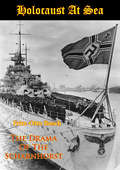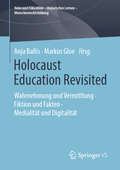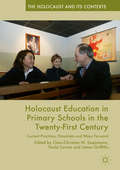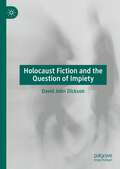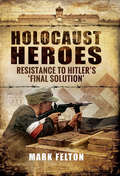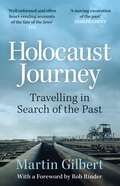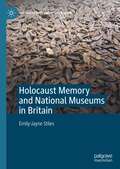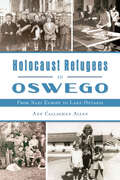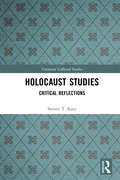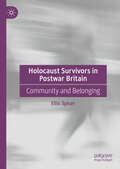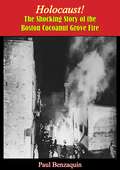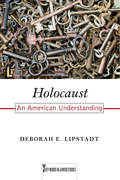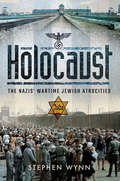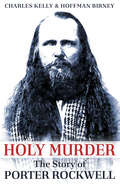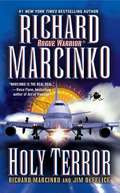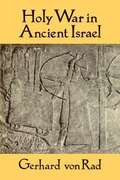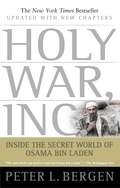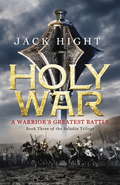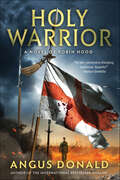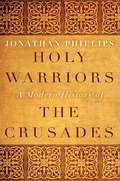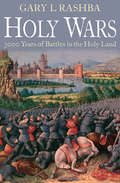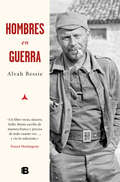- Table View
- List View
Holocaust At Sea: The Drama Of The Scharnhorst
by Fritz-Otto BuschOn Christmas Day, 1943, blinded by the fury of an Arctic blizzard, encircled by enemy destroyers, the German battleship Scharnhorst fought for her life.The luck of the Scharnhorst had become a legend. In 1942 she had slipped unscathed through the Channel under the very bows of the British fleet to harry the Arctic convoy-routes. The British convoy which sailed for Murmansk on Christmas Eve, 1943, seemed a perfect target for another lightning raid. In fact it was a trap to lure the battleship into the open and then destroy her.This is the story of the Scharnhorst’s dramatic sortie from her Norwegian lair.The story of a battle fought with outstanding courage against impossible odds until the most feared of all Hitler’s battleships sank at last off North Cape.
Holocaust Education Revisited: Wahrnehmung und Vermittlung • Fiktion und Fakten • Medialität und Digitalität (Holocaust Education – Historisches Lernen – Menschenrechtsbildung)
by Markus Gloe Anja BallisDer Band wendet sich Konzepten von „Holocaust Education“ zu, die auf einer Tagung an der LMU München im Februar 2018 diskutiert worden sind: Wissenschaftlerinnen und Wissenschaftler verschiedener Disziplinen reflektierten über Zieldimensionen, mediale Repräsentationen sowie Wandel und Herausforderungen bei der Vermittlung der Themenfelder Holocaust und NS-Verbrechen. Die kritische Auseinandersetzung mit Konzepten von „Holocaust Education“ hat sich auch im 21. Jahrhundert als produktiv erwiesen: Es kann ein vielstimmiger und auf die Gegenwart bezogener Diskurs entfaltet werden, der von Fragen der Vermittlung im Klassenzimmer bis zu der Virtualisierung von Zeugenschaft in Museen und daraus resultierender didaktischer Konsequenzen reicht. Der InhaltZur Einführung • Wahrnehmung und Vermittlung • Fiktionen und Fakten • Medialität und DigitalitätDie HerausgeberDr. Anja Ballis ist Professorin am Fachbereich Didaktik der deutschen Sprache und Literatur der Ludwig-Maximilians-Universität München.Dr. Markus Gloe ist Professor am Fachbereich Politische Bildung und Didaktik der Sozialkunde an der Ludwig-Maximilians-Universität München.
Holocaust Education in Primary Schools in the Twenty-First Century: Current Practices, Potentials and Ways Forward (The Holocaust and its Contexts)
by Paula Cowan Claus-Christian W. Szejnmann James GriffithsThis collection is the first of its kind, bringing together Holocaust educational researchers as well as school and museum educators from across the globe, to discuss the potentials of Holocaust education in relation to primary school children. Its contributors are from countries that have a unique relationship with the Holocaust, such as Germany, Israel, neutral Switzerland, and Allied countries outside the UK. Their research provides new insight into the diverse ways in which primary aged students engage with Holocaust education. Chapters explore the impact of teaching the Holocaust to this age group, school and museum teaching pedagogies, and primary students’ perspectives of the Holocaust. This book will appeal to school and museum educators of primary aged students whose work requires them to teach the Holocaust, Citizenship (or Civics) or Human Rights Education. Since the turn of the twenty-first century there has been a transformation in school and museum-based Holocaust education. This book clearly demonstrates that primary education has been included in this transformation.
Holocaust Fiction and the Question of Impiety
by David John DicksonThis book discusses the issues underlying contemporary Holocaust fiction. Using Gillian Rose’s theory of Holocaust piety, it argues that, rather than enhancing our understanding of the Holocaust, contemporary fiction has instead become overly focused on gratuitous representations of bodies in pain. The book begins by discussing the locations and imagery which have come to define our understanding of the Holocaust, before then highlighting how this gradual simplification has led to an increasing sense of emotional distance from the historical past. Holocaust fiction, the book argues, attempts to close this emotional and temporal distance by creating an emotional connection to bodies in pain. Using different concepts relating to embodied experience – from Sonia Kruks’ notion of feeling-with to Alison Landsberg’s prosthetic memory – the book analyses several key examples of Holocaust literature and film to establish whether fiction still possesses the capacity to approach the Holocaust impiously.
Holocaust Heroes: Resistance to Hitler's 'Final Solution'
by Mark FeltonThis inspiring book examines the often incredible and nearly always tragic examples of Jewish resistance in ghettos and concentration camps during the Nazis ‘Final Solution. It shows that the Warsaw Uprising in Poland during April to May 1944 was not the only occasion of defiant opposition. Throughout the Nazis extermination programme Jews and other prisoners fought back against their murderers, often with stunning results. The Germans were nearly always taken by surprise by the sudden emergence of armed Jewish resistance and often paid dearly. This happened in ghettos and concentration campos (including Treblinka, Auschwitz, Syrels and Sobibor) throughout Poland and the Ukraine. Some Jews tried to stop the machinery of the Holocaust by rising up and destroying the gas chambers while others bravely tried to take over an extermination camp and escape en masse. In virtually every case the brave men and women who volunteered to fight back paid with their lives. Importantly these men and women are not just portrayed as victims but also as brave and resourceful fighters and resisters against their tragic fate. These are stories that are uplifting, inspiring and often profoundly moving.
Holocaust Journey: Travelling In Search Of The Past
by Sir Martin GilbertIncludes a new foreword by Rob RinderWhat readers are saying about HOLOCAUST JOURNEY:'Brilliant ... A must read for everybody' ⭐⭐⭐⭐⭐'Devastating' ⭐⭐⭐⭐⭐'Fascinating, thought provoking and shocking' ⭐⭐⭐⭐⭐'Everybody should read this' ⭐⭐⭐⭐⭐'Informative and emotional' ⭐⭐⭐⭐⭐In June 1996 Martin Gilbert took a group of students on a two-week journey across middle-Europe which encompassed all the major places in the Holocaust - from Wannsee where the extermination of the Jews was decreed, to the camps themselves, via deserted Jewish communities and synagogues as well as the sites of the ghettos and deportation.'The achievement of Gilbert's HOLOCAUST JOURNEY is to reduce to comprehensible, human terms of the scale of the genocide that to many is still unimaginable' LITERARY REVIEW'Filled with short, well-informed and often heart-rending accounts of the fate of the Jews' TLS'HOLOCAUST JOURNEY travels along the tracks of a history we would rather forget to the sites of wartime horror, and is also a moving excavation of the past' INDEPENDENT
Holocaust Journey: Travelling In Search Of The Past
by Sir Martin GilbertIncludes a new foreword by Rob RinderWhat readers are saying about HOLOCAUST JOURNEY:'Brilliant ... A must read for everybody' ⭐⭐⭐⭐⭐'Devastating' ⭐⭐⭐⭐⭐'Fascinating, thought provoking and shocking' ⭐⭐⭐⭐⭐'Everybody should read this' ⭐⭐⭐⭐⭐'Informative and emotional' ⭐⭐⭐⭐⭐In June 1996 Martin Gilbert took a group of students on a two-week journey across middle-Europe which encompassed all the major places in the Holocaust - from Wannsee where the extermination of the Jews was decreed, to the camps themselves, via deserted Jewish communities and synagogues as well as the sites of the ghettos and deportation.'The achievement of Gilbert's HOLOCAUST JOURNEY is to reduce to comprehensible, human terms of the scale of the genocide that to many is still unimaginable' LITERARY REVIEW'Filled with short, well-informed and often heart-rending accounts of the fate of the Jews' TLS'HOLOCAUST JOURNEY travels along the tracks of a history we would rather forget to the sites of wartime horror, and is also a moving excavation of the past' INDEPENDENT
Holocaust Memory and National Museums in Britain (The Holocaust and its Contexts)
by Emily-Jayne StilesThis book explores the Holocaust exhibition opened within the Imperial War Museum (IWM) in 2000; setting out the long and often contentious debates surrounding the conception, design, and finally the opening of an important exhibition within a national museum in Britain. It considers a process of memory-making through an assessment of Holocaust photographs, material culture, and survivor testimonies; exploring theories of cultural memory as they apply to the national museum context. Anchored in time and place, the Holocaust exhibition within Britain’s national museum of war is influenced by, and reflects, an international rise in Holocaust consciousness in the 1990s. This book considers the construction of Holocaust memory in 1990s Britain, providing a foundation for understanding current and future national memory projects. Through all aspects of the display, the Holocaust is presented as meaningful in terms of what it says about Nazism and what this, in turn, says about Britishness. From the original debates surrounding the inclusion of a Holocaust gallery at the IWM, to the acquisition of Holocaust artefacts that could act as 'concrete evidence' of Nazi barbarity and criminality, the Holocaust reaffirms an image of Britain that avoids critical self-reflection despite raising uncomfortably close questions. The various display elements are brought together to consider multiple strands of the Holocaust story as it is told by national museums in Britain.
Holocaust Refugees in Oswego: From Nazi Europe to Lake Ontario (American Heritage)
by Ann Callaghan AllenAmerica's Only Shelter Established for Holocaust Refugees/ During the height of the second World War, at the order of President Roosevelt, Fort Ontario in Oswego, New York housed 982 refugees, rescued from the horrors of the Holocaust. The community of Oswego answered the call of service and opened its arms to the survivors. Oswegonian and WWII veteran Joseph Spereno's connection with refugee Jake Sylber helped launch his tailoring business that was a fixture in the city for more than 20 years. Then high school Principal Ralph Faust was among local educators who fought to allow the refugee children into Oswego schools, forging connections with those young people who went on to distinguished careers. Local Boy Scout leader Harold Clark created a troop for refugee children to share in the American experience of scouting.Author Ann Callaghan Allen presents the harrowing narrative of how Oswego gave shelter to hundreds of Holocaust survivors.
Holocaust Studies: Critical Reflections (Variorum Collected Studies)
by Steven T. KatzThe great majority of Holocaust scholarship concentrates heavily, if not almost completely, on the Final Solution from the German side. The distinctive feature of this book, both individually and as a collection, is its concentration on the Holocaust from a Judeo-centric point of view. The present essays make a unique contribution by exploring issues such as: the effect of events specifically on Jewish women and children; the character of the Nazi policy of slave labor in as much as this essential program resulted in different treatment with regard to Jews as compared to other workers; how the destruction of European Jewry has been responded to by Jewish thinkers; and how Jewish values, such as the well-known principle that "all Jews are responsible for each other," were exemplified and lived out during the war. The collection also includes an essay on Elie Wiesel, and another that explores the much discussed, very controversial issue of Jewish resistance, as well as several essays on philosophical and comparative issues raised by the Shoah.
Holocaust Survivors in Postwar Britain: Community and Belonging
by Ellis SpicerThis book pays particular attention to the experiences of younger child survivors of the Holocaust, considering how they kept in touch with one another, and how they integrated into larger cohorts of survivors settling in postwar Britain. Digging deeper than ever before into their postwar circumstances exposes the process of rebuilding shattered lives and the evolution of community relations, including both the beneficial and re-traumatising effects engendered by these networks. Newly conducted interviews put the experiences of younger survivors centre stage. These individuals did not receive much attention or status as survivors until the 1990s, and whilst they represent the most active cohort of survivor speakers in the UK, their narratives and community relations have been markedly absent from academic study.
Holocaust!: The Shocking Story of the Boston Cocoanut Grove Fire
by Paul BenzaquinFirst published in November 1959, this is the bestselling account of the fire at The Cocoanut Grove, a premier nightclub during the post-Prohibition 1930s and 1940s in Boston, Massachusetts, on the night of November 28, 1942.It was the scene of the deadliest nightclub fire in history, killing 492 people and injuring hundreds more. The scale of the tragedy shocked the nation and briefly replaced the events of World War II in newspaper headlines. It led to a reform of safety standards and codes across the U.S., and to major changes in the treatment and rehabilitation of burn victims internationally.Written by radio broadcaster and Boston Globe journalist, Paul Benzaquin, this book is widely regarded as one of the most harrowing tales in the annals of disaster: a story of panic and desperation, of chaos and utter fear, it is also a story of almost incredible courage and ingenuity in the midst of despair.What gives this story lasting value is its emphasis on the aftermath of the fire: the medical innovations wrought by hospital workers in their attempt to save lives; the change in safety regulations brought about by the official enquiry in to the causes of the fire.Paul Benzaquin has scrupulously sifted facts from fancy and with powerful dramatic force molded these and other important elements into a stunning narrative, making Holocaust! a powerful book.Unmissable reading.Contains a detailed layout plan of The Cocanut Grove illustrated with over 20 black-and-white photographs.
Holocaust: An American Understanding
by Deborah E. LipstadtImmediately after World War II, there was little discussion of the Holocaust, but today the word has grown into a potent political and moral symbol, recognized by all. In Holocaust: An American Understanding, renowned historian Deborah E. Lipstadt explores this striking evolution in Holocaust consciousness, revealing how a broad array of Americans--from students in middle schools to presidents of the United States--tried to make sense of this inexplicable disaster, and how they came to use the Holocaust as a lens to interpret their own history. Lipstadt weaves a powerful narrative that touches on events as varied as the civil rights movement, Vietnam, Stonewall, and the women's movement, as well as controversies over Bitburg, the Rwandan genocide, and the bombing of Kosovo. Drawing upon extensive research on politics, popular culture, student protests, religious debates and various strains of Zionist ideologies, Lipstadt traces how the Holocaust became integral to the fabric of American life. Even popular culture, including such films as Dr. Strangelove and such books as John Hershey's The Wall, was influenced by and in turn influenced thinking about the Holocaust. Equally important, the book shows how Americans used the Holocaust to make sense of what was happening in the United States. Many Americans saw the civil rights movement in light of Nazi oppression, for example, while others feared that American soldiers in Vietnam were destroying a people identified by the government as the enemy. Lipstadt demonstrates that the Holocaust became not just a tragedy to be understood but also a tool for interpreting America and its place in the world. Ultimately Holocaust: An American Understanding tells us as much about America in the years since the end of World War II as it does about the Holocaust itself.
Holocaust: The Nazis' Wartime Jewish Atrocities
by Stephen Wynn“Trace[s] the developing Holocaust from the Odessa Massacre . . . a very good point to start into understanding this terrible genocide.” —FiretrenchIn Holocaust, Stephen Wynn looks at the build up to the Second World War, from the time of Hitler’s appointment as Chancellor of Germany in January 1933, as the Nazi Party rose to power in a country that was still struggling to recover politically, socially and financially from the aftermath of the First World War, while at the same time, through the enactment of a number of laws, making life extremely difficult for German Jews. Some saw the dangers ahead for Jews in Germany and did their best to get out, some managed to do so, but millions more did not. The book then moves on to look at a wartime Nazi Germany and how the dislike of the Jews had gone from painting the star of David on shop windows, to their mass murder in the thousands of concentration camps that were scattered throughout Germany. As well as the camps, it looks at some of those who were culpable for the atrocities that were carried out in the name of Nazism. Not all those who were murdered lost their lives in concentration camps. Some were killed in massacres, some in ghettos and some by the feared and hated Einsatzgruppen.“Historical studies like Holocaust: The Nazis’ Wartime Jewish Atrocities are increasingly necessary to remind present and future generations of what can happen when the forces of bigotry and racially motivated hatred goes unchecked in even the most civilized of nations.” —Midwest Book Review
Holy Murder: The Story of Porter Rockwell
by Charles Kelly Birney HoffmanHoly Murder, first published in 1934, is a fascinating, controversial look at the “Avenging Angel” of the Mormon Church, Porter Rockwell. The authors trace the violent history of the Mormon Church beginning with its origins in New York and Illinois, to the flight of its members and their settlement near the Great Salt Lake. Citing numerous sources and interviewing witnesses and descendants, the exploits of Rockwell are detailed to form a picture of a man on the one hand kind to children and his friends, while on the other capable of the most grisly murders of perceived enemies of the church. Although open to criticism for its anti-Mormon bias, attempting to accurately portray Rockwell is difficult as he did not keep a personal diary and many of his activities were shrouded in secrecy. Included are 12 pages of illustrations.
Holy Terror (Rogue Warrior #13)
by Richard MarcinkoNo one has ever accused Richard Marcinko -- aka Rogue Warrior® -- of being an altar boy, but in the latest installment of his bestselling series, Demo Dick finds himself darkening the aisles of St. Peter's Basilica in Vatican City, tracking a group of terrorists who want to turn the world's largest Catholic church into the world's biggest Roman candle. A trip to Italy for Dick Marcinko turns into more than pasta and gondola rides. Nothing and no one is sacred as Marcinko sprays irreverent asides, targeting everything from antiterror wannabes to the nuns who taught him in parochial school. Called "the real deal" by Vince Flynn, the bestselling author of Memorial Day, Marcinko entertains, informs, and even finds time to genuflect in his new book. Visiting a NATO conference in Rome, Demo Dick blisters bureaucratic ears with a speech about Europe's vulnerabilities and the need to get serious about terrorism. He caps off his talk with an impromptu demonstration of the threat, unmasking a plot to kill the conferees seconds before it begins -- and just in time to play volleyball with a live hand grenade. The action ratchets up from there as the former SEAL commander is shanghaied to Sicily to help investigate the attempted theft of nukes from a U.S. base. Is the Mafia involved? Or is this the work of Saladin, a shadowy extremist trying to step into bin Laden's shoes? A high body count lends credence to both theories, but before Demo Dick can untangle the plot, his firm is hired to track down "shrinkage" in a courier operation in Asia. Since said shrinkage involves data and currency worth hundreds of millions of dollars, Demo Dick anticipates a Rogue-sized finder's fee. But he soon discovers the job is a trap. Lured to a cave filled with outrageously hungry tigers in the Thailand jungle, Demo Dick sucks cat breath before being saved by the beautiful if prickly Trace Dahlgren and veteran Rogue sideman Al "Doc" Tremblay. Marcinko has only escaped the frying pan for the fire; he rides a hijacked jet back to Italy, where Saladin plans to wrap up the plot's loose ends in a bonfire at the center of the Eternal City. In Holy Terror, Marcinko mixes his trademark wit and wisdom with nonstop action in a romp across Europe and Asia.
Holy War in Ancient Israel
by Gerhard Von RadTranslation of Der Heilige Krieg im alten Israel from German into English.
Holy War, Inc.: Inside the Secret World of Osama Bin Laden
by Peter L. BergenOn September 11, 2001, the world in which we live was changed forever. The twin towers of the World Trade Center came crashing down, one side of the Pentagon burst into flame, and more than six thousand men, women, and children lost their lives in the most deadly terrorist attack on American soil. As shocking as it was, it had been long in the making: The assault was the most sophisticated and horrifying in a series of operations masterminded by Osama bin Laden and his Jihad group -- an organization that CNN's terrorism analyst Peter Bergen calls Holy War, Inc. One of only a handful of Western journalists to have interviewed the world's most wanted man face to face, Peter Bergen has produced the definitive book on the Jihadist network that operates globally and in secrecy. In the course of four years of investigative reporting, he has interviewed scores of insiders -- from bin Laden associates and family members to Taliban leaders to CIA officials -- and traveled to Afghanistan, Yemen, Egypt, Pakistan, and the United Kingdom to learn the truth about bin Laden's al Queda organization and his mission. Immense in scope and unnerving in its findings,Holy War, Inc. reveals:How bin Laden lives, travels, and communicates with his "cells. " How his role in the crushing defeat of the Soviet Union in Afghanistan made him a hero to Muslims all over the world -- and equipped him to endure a long and bloody siege. How the CIA ended up funding -- to the tune of three billion dollars -- radical, anti-American Afghan groups allied to bin Laden. How the attacks that foreshadowed the destruction of the World Trade Center -- among them the bombings of the American embassies in Africa and the warship USSColein Yemen -- were planned and executed. The dimensions of bin Laden's personal fortune, and why freezing his assets is both futile and nearly impossible. The ideology of bin Laden's number two, the man who has influenced him most profoundly in his holy war -- the Egyptian Ayman al Zawahiri. What we can expect from Islamist extremists in the future. Above all, Peter Bergen helps us to see bin Laden's organization in a radically new light: as a veritable corporation that has exploited twenty-first-century communications and weapons technologies in the service of a medieval reading of the Koran and holy war. Holy War, Inc. is essential reading for anyone trying to understand tomorrow's terrorist threats and the militant Islamist movements that could determine the fate of governments -- and human lives -- the world over. Both author and publisher will donate a portion of the proceeds from this book to United Way's September 11th Fund for the relief of victims of the World Trade Center attacks.
Holy War: Book Three of the Saladin Trilogy
by Jack HightIn HOLY WAR, the final book of the Saladin Trilogy, telling the story of the legendary war leader who united Arabia, Saladin recaptures Jerusalem from the Crusaders, and prepares for his ultimate battle against Richard the Lionheart. A full-blooded historical adventure novel for all fans of Conn Iggulden, Bernard Cornwell, Anthony Riches, Ben Kane, Robyn Young and Simon Scarrow.While Saladin ruthlessly sets about uniting the whole of Arabia under his rule, the Kingdom of Jerusalem is torn apart by treachery and intrigue, and when the murderous knight Reynald of Chatillon raids a caravan heading from Damascus to Mecca and rapes Saladin's sister, the scene is set for war.In June 1187, Saladin marches into the Kingdom with an army of over 24,000 and imposes a crushing defeat on the Crusader forces at the Horns of Hattin. It is only a matter of time before he marches on a panicked and demoralized Jerusalem.But what about Saladin's longtime ally, the Saxon knight John of Tatewic? In the face of annihilation, is he friend or foe? It will take all John's knowledge of the man he calls his brother to negotiate a peaceful fate for Jerusalem - but this is not the end of the story. For in England the soon-to-be crowned King Richard has pledged revenge and a new Crusade . . .
Holy Warrior: A Novel of Robin Hood (The Outlaw Chronicles #2)
by Angus DonaldRobin Hood and his sidekick, Alan Dale, battle Saracens in the Crusades and treachery in his camp in this historical adventure by the author of Outlaw.In 1190 A.D. Richard the Lionheart, the new King of England, has launched his epic crusade to seize Jerusalem from the Saracens. Marching with the vast royal army is Britain’s most famous, feared, and ferocious warrior: the Outlaw of Nottingham, the Earl of Locksley—Robin Hood himself. With his band of loyal men at his side, Robin cuts a bloody swath on the brutal journey east. Daring and dangerous, he can outwit and outlast any foe, but the battlefields of the Holy Land are the ultimate proving ground. And within Robin’s camp lurks a traitor—a hidden enemy determined to assassinate England’s most dangerous rogue.Richly imagined and furiously paced, featuring a cast of unforgettable characters, Holy Warrior is adventure, history, and legend at its finest.
Holy Warriors: A Modern History of the Crusades
by Jonathan PhillipsWhen George Bush inaugurated the War on Terror in 2001, he referred to it as a 'crusade'. A medieval Crusade could be defined thus: a holy war initiated by the Pope on God's behalf in which the participants took the cross and received remission for their sins. The First Crusade, launched in 1095, ushered in a period of almost 200 years of Christian rule in the Levant, yet over time crusades were directed against a variety of opponents, not just Muslims in the Middle East: against Cathar heretics, political enemies of the papacy, the Mongols, pagan tribes of northern Europe, and the Ottoman Turks, well into the sixteenth century. While the notion of fighting for one's faith fell into disrepute during the Enlightenment, whose proponents viewed the idea as primitive and barbaric, in reality the cultural engines of romanticism and orientalism gave the memory of the crusades a significant boost in the nineteenth century. The notion of moral right buttressed by royal authority helped to drive the expansion of European power through imperialism and colonialism, and in both World Wars the theme of crusading was used as a call to arms. As Jonathan Philips demonstrates in this timely and revealing study, crusading has proven to be a remarkably adaptable and long-lasting phenomenon, embedded in the actions and consciousness of the West for centuries. Unlike other histories of the Crusades this one firstly comes up to the present day and secondly, avoids a chronological slog through the whole movement. Instead it drills a series of bore holes into the key aspects and moments: The First Crusade, Richard the Lionheart and Saladin, the Templars, the Jihad, etc. Thirdly, it is incredibly vivid and accessible - we hear the swords, taste the food, see the sights and feel the heat.
Holy Wars: 3000 Years of Battles in the Holy Land
by Gary L. Rashba&“A compelling tale of how this spiritually and politically charged area of the globe has long been a place of pivotal battles&” (Library Journal). Today&’s Arab-Israeli conflict is merely the latest iteration of an unending history of violence in the Holy Land—a region that is unsurpassed as witness to a kaleidoscopic military history involving forces from across the world and throughout the millennia. Holy Wars describes three thousand years of war in the Holy Land with the unique approach of focusing on pivotal battles or campaigns, beginning with the Israelites&’ capture of Jericho and ending with Israel&’s last full-fledged assault against Lebanon. Its chapters stop along the way to examine key battles fought by the Philistines, Assyrians, Greeks, Romans, Arabs, Crusaders, and Mamluks—the latter clash, at Ayn Jalut, comprising the first time the Mongols suffered a decisive defeat. The modern era saw the rise of the Ottomans and an incursion by Napoleon, who only found bloody stalemate outside the walls of Akko. The Holy Land became a battlefield again in World War I when the British fought the Turks. The nation of Israel was forged in conflict during its 1948 War of Independence, and subsequently found itself in desperate combat, often against great odds, in 1956 and 1967, and again in 1973, when it was surprised by a massive two-pronged assault. By focusing on the climax of each conflict, while carefully setting each stage, Holy Wars examines an extraordinary breadth of military history—spanning in one volume the evolution of warfare over the centuries, as well as the enduring status of the Holy Land as a battleground.
Hombres en guerra
by Alvah BessieLa obra maestra olvidada sobre la guerra civil española que fascinó a Ernest Hemingway. Hombres en guerra es un clásico que habla de soldados en la línea de fuego, y uno de los mejores testimonios jamás escritos sobre cualquier guerra. Su autor, Alvah Bessie, fue un escritor y periodista estadounidense que en 1938 combatió en la guerra civil española como voluntario de la Brigada Lincoln. Al volver a su país convirtió los cuadernos que había escrito durante la contienda en la base de este libro, que fue publicado en inglés en 1939 -gracias al apoyo de Ernest Hemingway-, coincidiendo con la invasión de Polonia por parte de la Alemania nazi. Pronto Bessie se convirtió en un reconocido guionista de la Warner Brothers. Sin embargo, en 1950, tras ser acusado por el macartismo de pertenecer al Partido Comunista, fue uno de los Diez de Hollywood, el grupo de personas obligadas a abandonar la industria cinematográfica. Estamos, pues, ante una obra de no ficción que posee un alto valor histórico y literario. En ella Alvah Bessie narra su llegada a España, su incorporación a la Brigada Lincoln, su adiestramiento y su participación en la batalla del Ebro; comparte con nosotros sus marchas nocturnas hasta la primera línea de fuego y los momentos de intimidad... Y al hacerlo nos ofrece un testimonio, entrañable y profundamente humano, de aquellos hombres y mujeres que vinieron de todos los rincones del mundo para luchar por una misma causa.
Home Before Morning: The Story of an Army Nurse in Vietnam
by Lynda Van Devanter Christopher MorganLynda Van Devanter was the girl next door, the cheerleader who went to Catholic schools, enjoyed sports, and got along well with her four sisters and parents. After high school she attended nursing school and then did something that would shatter her secure world for the rest of her life: in 1969, she joined the army and was shipped to Vietnam. When she arrived in Vietnam her idealistic view of the war vanished quickly. She worked long and arduous hours in cramped, ill-equipped, understaffed operating rooms. She saw friends die. Witnessing a war close-up, operating on soldiers and civilians whose injuries were catastrophic, she found the very foundations of her thinking changing daily. <P><P> After one traumatic year, she came home, a Vietnam veteran. Coming home was nearly as devastating as the time she spent in Asia. Nothing was the same ― including Lynda herself. Viewed by many as a murderer instead of a healer, she felt isolated and angry. The anger turned to depression; like many other Vietnam veterans she suffered from delayed stress syndrome. Working in hospitals brought back chilling scenes of hopelessly wounded soldiers. A marriage ended in divorce. The war that was fought physically halfway around the world had become a personal, internal battle.<P> Home before Morning is the story of a woman whose courage, stamina, and personal history make this a compelling autobiography. It is also the saga of others who went to war to aid the wounded and came back wounded ― physically and emotionally ― themselves. And, it is the true story of one person's triumphs: her understanding of, and coming to terms with, her destiny.
